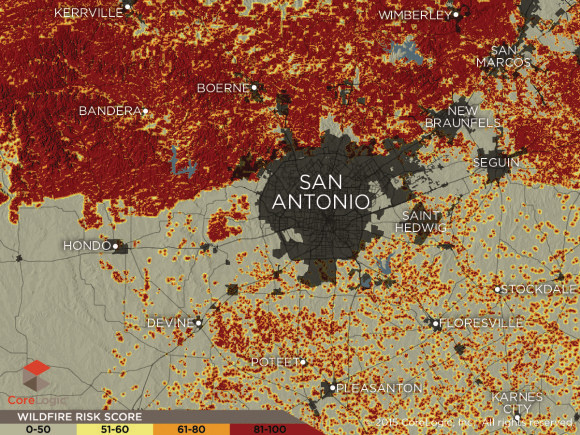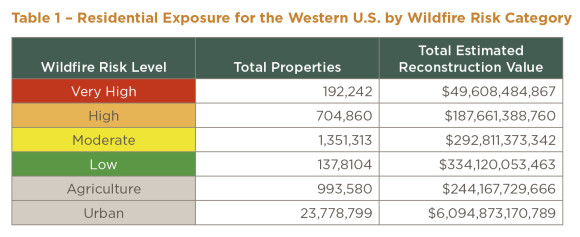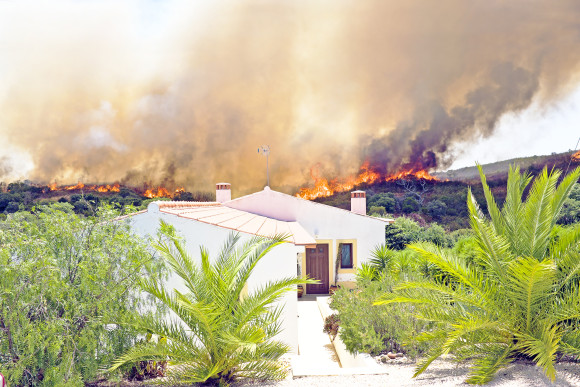In the Western United States there are nearly 900,000 homes representing an estimated reconstruction cost of more than $237 billion considered at “very high” or “high” risk from wildfires, a report issued in Ferbruary shows.
CoreLogic’s Wildfire Risk analysis is the latest of the firm’s running wildfire risk assessment reports. A report in 2013 from the property and analytics firm using different metrics showed $189 billion worth of properties in the Western United States were at “high risk.”
This year’s report assigns risk scores for properties from 1 to 100, which indicates the level of susceptibility to wildfire, as well as the risk associated with the property being located in close proximity to another high-risk property or area.
For purposes of the study, the analysis divides the western states into four separate regions: Pacific Northwest, Northern Rockies, Desert and Pacific Southwest, and Southern Rockies and South Central United States, which includes Texas and Oklahoma.
The report gives 1.1 million Western U.S. homes the highest score segment (81-100), representing a combined potential reconstruction value of more than $268.5 billion.
“You’re always a little shocked when you see the numbers,” said Tom Jeffery, a CoreLogic senior hazard scientist, who was involved in putting the report together.
While those homes in the 81-100 segment may not be fire hazards themselves, their proximity to the wildland area should be a concern, he said.
“Some of these homes are tremendously high risk,” Jeffery added.
More surprising to Jeffery was that with much of the West in an ongoing drought, there were few major losses due to wildfire last year. Last year saw the second fewest number of major wildfires over the past two decades and it recorded the second lowest total for acreage burned in the last 10 years, the report shows.
“I think we really kind of dodged a bullet last year,” he said.
Jeffery offered a few reasons for last year’s relatively tame wildfire season, putting luck at the top of his list.
He also credited state and regional governments, and fire officials, for large responses in terms of equipment and personnel to even small fires, which has helped contain some potentially disastrous blazes.
Timely precipitation – also luck – had a hand in a few other fires, and lastly Jeffery credited more homeowners in the wildland-urban interface for being proactive by doing things like taking care of excess brush, treating wooden structures and trimming nearby trees.
“I think the homeowners have really taken mitigation to heart,” he said.
With the 2015 fire season just around the corner, Jeffery isn’t so sure this year will be such a lucky one.
While some parts of the West broke free of drought conditions over the past year and received some precipitation, Jeffery considers that a double-edged sword because the rainfall will also lead to growth in vegetation or, as he calls it, “fuel.”
High Risk Metro Areas
The report cited the San Antonio-New Braunfels, Texas, area as one of the riskiest metropolitan regions in the West.
One of the fastest growing urban areas in the United States between 2000 and 2010, San Antonio’s population now totals more than 1.4 million. This expansion means that many properties are now located near wildlands areas. The report identified more than 31,000 homes as being in the high risk group in the San Antonio-New Braufels region, with an estimated combined reconstruction cost of more than $7 billion.

Another of the West’s riskiest regions, according to the report, is the Denver-Aurora-Lakewood, Colo., area, where 17,860 homes are at “very high” risk, representing more than $5.35 billion in reconstruction value.
San Francisco-Oakland-Hayward County was also cited in the study as a major metropolitan region at risk for wildfires, with an estimated 5,800 properties located in areas of highest risk. Combined reconstruction costs are estimated to total more than $2.7 billion.
California, Colorado and Texas have the largest number of homes at “very high” wildfire risk, according to the report. There were 50,905 such homes in California, representing more than $16.1 billion in reconstruction value. In Colorado there were 49,667 homes considered “very high” risk, followed by Texas (35,016), Oregon (13,788), Idaho (11,078), Montana (9,601) and Arizona (8,089).
Texas led with the most homes at “high risk,” with 261,855, followed by California (255,023), Oregon (51,872) and Colorado (50,009).
Looking Ahead
The report notes that precipitation and drought are the “most tangible influences on potential wildfire activity.”
It cites the National Oceanic Atmospheric Administration’s Climate Prediction Center as showing a slightly reduced scope of drought conditions in the West in 2015. However, some areas likely will continue to experience drought conditions for the first three quarters of this year. In Texas, the report predicts a “significant portion” of the state will continue to experience drought conditions at least through the early spring.
“If the drought continues throughout the year, it is likely that wildfire risk will also rise in these areas,” the report said.

Topics Catastrophe Natural Disasters USA California Texas Wildfire Homeowners
Was this article valuable?
Here are more articles you may enjoy.



 Former CEO of Nonprofit P/C Statistical Agent Sentenced for Stealing Millions
Former CEO of Nonprofit P/C Statistical Agent Sentenced for Stealing Millions  Louvre Tightens Security After $102M Jewel Heist, Installs Bars on Infamous Window
Louvre Tightens Security After $102M Jewel Heist, Installs Bars on Infamous Window  Abundant Reinsurance Capacity Accelerates Market Softening During 1/1 Renewals
Abundant Reinsurance Capacity Accelerates Market Softening During 1/1 Renewals  Top National Insurance Journal Stories of 2025
Top National Insurance Journal Stories of 2025 


